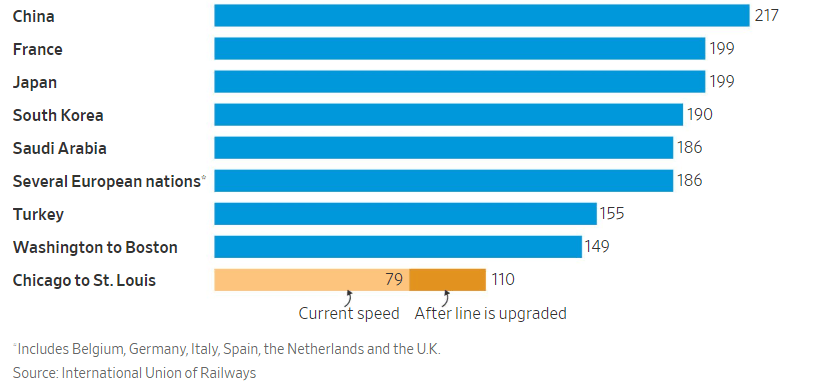The Wall Street Journal published an interesting article on why high-speed rail failed in the U.S. using the example of the state of Illinois and its efforts to one route from Chicago to St.Louis. The piece touches on a few points but leaves out many. Some of these were noted by its readers in the comments section of the article. I would discuss some of my thoughts on why hi-speed rail can’t succeed in the U.S. in a future post.
Below is an excerpt from the journal article:
Amtrak’s route from Chicago to St. Louis would seem an ideal place for the U.S. to adopt high-speed rail such as in Europe and Asia, where passenger trains can race along at 200 miles an hour. The stretch in Illinois is a straight shot across mostly flat terrain.
In fact, a fast-rail project is under way in Illinois. Yet the trains will top out at 110 mph, shaving just an hour from what is now a 5½-hour train trip.
After it’s finished, at a cost of about $2 billion, the state figures the share of people who travel between the two cities by rail could rise just a few percentage points.
Behind such modest gains, for hundreds of millions of dollars spent, lie some of the reasons high-speed train travel remains an elusive goal in the U.S.
All Aboard!
The fastest passenger trains are abroad. Top speeds of existing high-speed rail lines, in miles per hour.
Source: High-Speed Rail in the U.S. Remains Elusive: Illinois Shows Why, WSJ, Mar 5, 2019
Illinois didn’t have the money, or the right-of-way, to lay tracks that would be exclusively for a high-speed service. So its fast passenger trains will have to share the track with lumbering freight trains.
“To build the kind of infrastructure that is stand-alone—that is, just for high-speed passenger rail—it is just absurdly expensive and just takes years and years and years to get through the permitting and environmental process,” said Randy Blankenhorn, who was Illinois’s transportation secretary until this year.
“Land acquisition alone [would] take half a decade,” he said. “If we were to have said from the beginning, right off the bat go to 200-mile-an-hour service, we’d still be in the implementing and design phase.”
Illinois settled for weaving improvements along the route and rebuilding an existing single-track line that is owned by freight railroads. In effect, it chose higher-speed rail rather than actual high-speed.
Interested readers may want to read the whole piece.




